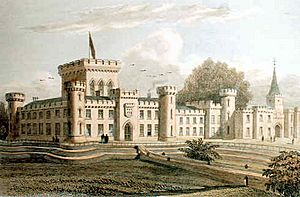Lee Castle, South Lanarkshire facts for kids
Quick facts for kids Lee Castle |
|
|---|---|

Lee Castle drawn in 1830 by John Preston Neale
|
|
|
Listed Building – Category B
|
|
| Designated | 12 January 1971 |
| Reference no. | LB13056 |
|
Inventory of Gardens and Designed Landscapes in Scotland
|
|
| Designated | 1 July 1987 |
| Reference no. | GDL00257 |
| Lua error in Module:Location_map at line 420: attempt to index field 'wikibase' (a nil value). | |
Lee Castle, also known as The Lee, is a large house that looks like a castle. It is found in Auchenglen, a beautiful part of the Clyde Valley in South Lanarkshire, Scotland. The castle is about 1.5 kilometers south of Braidwood and 4 kilometers north-west of Lanark.
Lee Castle was the home of the Lockharts of Lee family for a very long time, starting in the 1200s and lasting until 1919. The building you see today was mostly rebuilt in the 1800s. This historic house is protected as a special "category B listed building." Its beautiful gardens are also recognized as important in the Inventory of Gardens and Designed Landscapes in Scotland.
Contents
History of Lee Castle
The Lockhart Family and the Bruce's Heart
The story of Lee Castle begins in 1272. That's when William Locard was given the special title of "Baron of Lee," meaning he owned the land. His son, Sir Simon Locard (who lived from 1300 to 1371), was a brave knight. He fought in the Wars of Scottish Independence, which were battles for Scotland's freedom.
After these wars, Sir Simon went on an important journey. He joined Sir James Douglas in 1330. Their mission was to take the heart of Robert the Bruce, a famous Scottish king, to the Holy Land. Sadly, Sir James Douglas died in a battle in Spain. Sir Simon then carried the Bruce's heart back to Scotland. It was buried at Melrose Abbey.
Because of this journey, Sir Simon added a heart and a fetterlock (a type of padlock) to his family's coat of arms. This symbol is still part of the Lockhart family crest today. He also got a special object called the "Lee Penny." This small amulet was believed to have healing powers. The Lee Penny is still owned by the family.
Important Lockharts Through the Centuries
Many members of the Lockhart family played big roles in history. Sir William Lockhart of Lee (1621–1675) first fought for the King during the English Civil War. But he later changed sides and even married the niece of Oliver Cromwell, a powerful leader. Sir William became an important official in Scotland for Cromwell. He also served as England's ambassador to France.
His brother, George Lockhart, became a top lawyer in Scotland. He bought more land in Lanarkshire. Both the Lee and Carnwath estates were passed down to Sir William's son, Sir George Lockhart of Lee (1673–1731). This Sir George helped create the Act of Union between England and Scotland in 1707. However, he later supported the Jacobite cause, which wanted to bring back the old royal family. He was involved in the Jacobite Rising of 1715, but he wasn't punished too severely.
Sir George's grandson, also named George, fought with the Jacobites in the Jacobite Rising of 1745. After the uprising, he had to leave Scotland. His younger brother, James, also went abroad. He fought in the Austrian army during the Seven Years' War. James eventually inherited the Lee estates. He was even given a special title, "Count of the Holy Roman Empire," in 1782. His nephew, Alexander Lockhart of Lee, who was a Member of Parliament, received another special title, "baronet," in 1806.
Building the Modern Castle
By the mid-1700s, the beautiful parklands around Lee Castle were already designed. We know this from old maps made by William Roy. However, we don't know exactly what the house looked like back then.
In 1817, Sir Charles Lockhart, the 2nd Baronet, built a new house at Lee. But after he died, Sir Norman Lockhart, the 3rd Baronet, decided to build an even bigger house. He hired a famous architect named James Gillespie Graham. Work started in 1834 and finished in 1845. The new design included parts of the older building. Later, in the late 1800s, the 5th baronet made some changes to the parklands.
Lee Castle in Modern Times
When the 5th baronet died in 1919, the special "baronet" title for the Lockharts of Lee ended. In 1948, the house and its land were sold outside the family. Later, in the 1970s, the estate was divided up.
More recently, a person named Terence Alvis became the 33rd Baron of Lee. He spent ten years restoring the house. In 2004, Lee Castle, along with about 250 acres of land, was put up for sale on the internet site eBay. It didn't sell there, but it was later sold to an American buyer. This sale set a new record for the highest price ever paid for a private home in Scotland.

